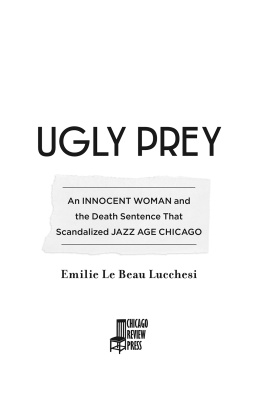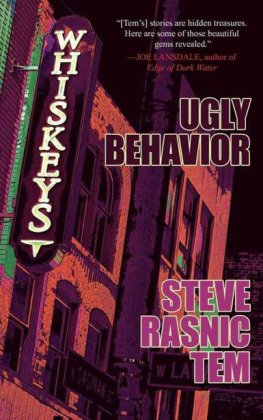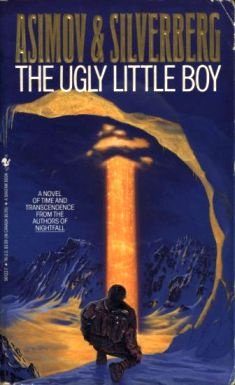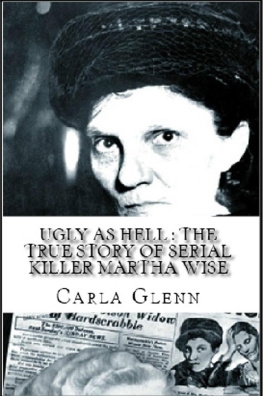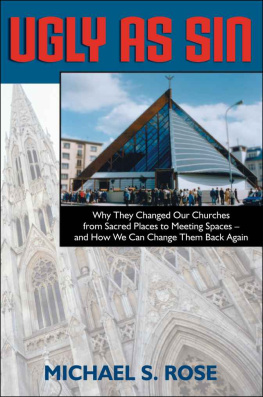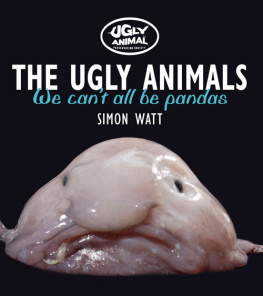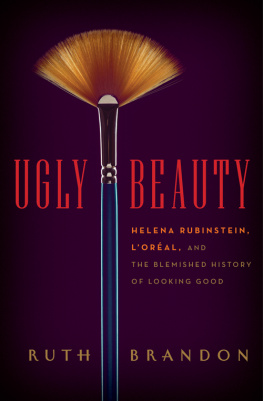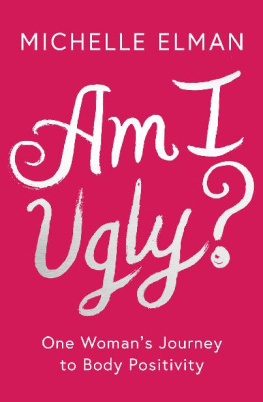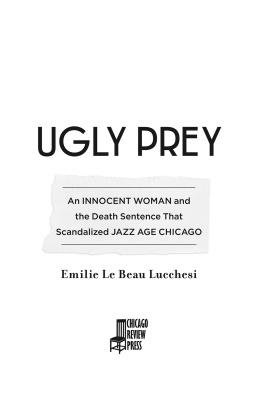Sommaire
Pagination de l'dition papier
Guide
Copyright 2017 by Emilie Le Beau Lucchesi
All rights reserved
Published by Chicago Review Press Incorporated
814 North Franklin Street
Chicago, Illinois 60610
ISBN 978-1-61373-699-9
Library of Congress Cataloging-in-Publication Data
Is available from the Library of Congress.
Typesetting: Nord Compo
Printed in the United States of America
5 4 3 2 1
This digital document has been produced by Nord Compo.
TO MY TANA, NELLA LUCCHESI THALJI
AND TO MY HUSBAND, MICHAEL LUCCHESI,
FOR MANY, MANY REASONS
KEY FIGURES
SABELLA NITTI: Real name Isabella Maria Travaglia. Immigrant from Bari, Italy, about age forty-four in 1923. Lives with family in Stickney, Illinois, on a truck garden farm.
FRANCESCO NITTI: Sabellas first husband. Deceased or missing as of July 1922. Immigrant from Bari. About age fifty-six when he disappears from the Stickney farm.
PETER CRUDELE: Real name Pietro. Immigrant from Bari. About age twenty-two in 1923. Works on Nitti family farm as a farmhand. Becomes Sabellas husband in March 1923.
JAMES NITTI: Real name Vincenzo. Immigrant from Bari. About age twenty-five in 1923. Sabellas oldest son. Married but a wanderer.
MICHAEL NITTI: Real name Michele. Immigrant from Bari. About age twenty-one in 1923. Sabellas second son.
CHARLEY NITTI: Real name Pasquale. Immigrant from Bari. About age seventeen in 1923. Sabellas third son. Lives on family farm in Stickney.
FILOMENA NITTI: Called Philomena or Fily. Born in the United States. About age six in 1923. Sabellas fourth child. Lives on family farm in Stickney.
MARY NITTI: Real name Maria. Born in the United States. About age four in 1923. Sabellas fifth and youngest child. Lives on family farm in Stickney.
DEPUTY SHERIFF PAUL DASSO: Cook County deputy sheriff. Son of Italian immigrants. Leads charge against Sabella.
EUGENE A. MORAN: Sabella and Peters first defense attorney.
HELEN CIRESE: A member of the defense team representing Sabella and Peter on appeal. Young, beautiful, and Italian, Cirese was shut out of the major Chicago law firms.
MILTON SMITH: A prosecuting attorney.
MICHAEL ROMANO: A prosecuting attorney.
GENEVIEVE FORBES: A Chicago Daily Tribune reporter who covers Sabellas case.
MICHELE DESANT: Farmhand who lives in a shanty behind the Nitti family farm with his wife. Immigrant from Bari, also serves as a translator during the trial.
JAMES AND ANNA VOLPE: Bari immigrants, witnesses for the prosecution.
Part I
GUILTY
THAT MEANS A HANGING!
July 9, 1923
I N THE EARLY AFTERNOON, the jury filed back into the courtroom with a verdict. The twelve men kept their eyes low, diverted from the defendants table. They knew they were sending this middle-aged woman, Sabella Nitti, and her young husband, Peter Crudele, to the gallows.
They had made the decision in the deliberation room, voting a dozen times until they came to agreement. It was the right thing to do, they believed, to bring Francesco Nittis killers to justice. But it didnt feel right to send a woman to the gallows. She would be the first woman to hang in Cook County, and that was a heavy burden on the jurors consciences.
The audience in the courtroom read the jurors faces, trying to get a sense of what they decided. One man, a regular murder trial attendee, voiced his veteran opinion to the other courtroom enthusiasts. That means a hanging!
Peter stiffened in his wooden chair at the defendants table. At twenty-two, he was almost two decades younger than his wife, and he had picked up the English language soon after emigrating from the Adriatic Coast to the Chicago area a few years back. He understood what the observers were saying. They believed he was a doomed man and they talked about the possibility of him hanging as if they were watching a motion picture or reading a detective magazine.
Peter had a long oval face, dark hair, and pale skin. He hardened his jaw and locked his dark eyes on the desk in front of him. He was a handsome young man, and his good looks contrasted with his aging wife. Peter and Sabella had been married only two months when they were arrested, along with Sabellas youngest son, Charley, for the murder of her former husband. Prosecutors claimed the mismatched couple had killed Francesco Nitti the previous July so they could be together.
Peter likely sensed how the spectators at the trial thought the worst of him and Sabella. The charges against Sabellas son had been dropped just days before, and the boy sat in the gallery with the rest of the audience, eager to hear the fate of his mother and stepfather. The boy might have been one of the few people in the courtroom not hoping for a conviction.
From the audience, reporter Genevieve Forbes studied the defendants, paying attention to every foreign detail about the woman in particular. If it were up to Forbes, she would find Sabella guilty and hang the old woman that very night. Forbes was disgusted by Sabella. This little Italian woman was everything that Americans reviled about these invading Southern Europeans. Sabella didnt speak English. She was dirty. Violent. Ignorant. Uneducated. She clung to her backward ways, and she clearly cared nothing for American rules and order. Maybe in Italy a woman was free to bludgeon her husband to death and marry a much younger farmhand. But there was a proper justice system in Cook County, which Forbes wrote about for the Chicago Daily Tribune. Later that day, she would sit at her portable typewriter in the newsroom on Madison Street and describe Sabella as the dumb, crouching, animal-like peasant.
At first glance, Forbes appeared to be Sabellas polar opposite. Forbes was slender and light. She was not particularly pretty but she had fine featuresa slender nose, thin lips, and light eyes. To Forbes, Sabella was a peasant who lookedand smelledlike she had just walked out of a field. Sabella was a compact woman with a muscular frame built during a lifetime of work. Her olive skin had deepened like tanned leather after years of toiling in the Mediterranean sun. She had long, thick black and gray hair that she piled onto her head in a messy bun and secured with pins and combs. Across the courtroom, her hair looked filthy, and several times Forbes wrote the word greasy in her notebook as a description of this little womans appearance.
If Sabella had been born under different circumstances, it would have been easy to describe her as pretty. She had fine, arched eyebrows and round, close-set eyes. She had a slender nose, a wide mouth, and a defined jawline. In another life shaped by school or cotillion, a young Sabella might have charmed men by looking up at them with a wide smile and long, fluttering eyelashes. But a lifetime of desperation and work under the sun made it easy for Forbes to call Sabella grotesque in the news reports.
It was not just her appearance that irked Forbesit was her manners. Sabella appeared in public without a hat, which proved to Forbes that this murderer lacked any tact or class. And she showed up to court as if she was ready to work on a corn row. Sabella wore a long-sleeved dark work shirt to the trial and a heavy, long dark-blue skirt. Her skirt was full, but it had been shortened for work in the field. Her attire was far too heavy for a hot courtroom in July, and Forbes watched as the doomed woman took out a small square of fabric and wiped sweat off her brow.
Judge Joseph David peered down at the packed courtroom. The gallery was crowded with spectators who had read about the murder trial in the newspapers and wanted to be there for the big moment. Many of them were Italian, and Judge David suspected they might disrupt the courtroom after the verdict was read.

